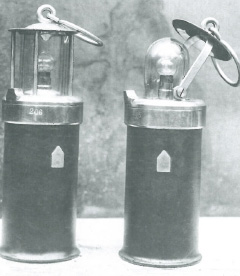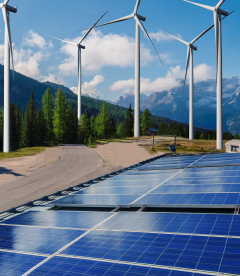Why Stabilizing the Grid can be done so Efficiently with Batteries
Application
March 27. 2025
2 min.
Keeping the grid in balance is a never-ending effort using mechanisms such as FCR, aFRR, mFRR, and RR. These abbreviations denote grid stabilizing, or ancillary, services which are increasingly provided by batteries.

Ancillary services are, in fact, an umbrella term for a range of functions that goes even beyond frequency control mentioned above. Among them are voltage control and reactive power management. The grid, i.e. both the equipment that generates and transmits power as well as whatever consumes it, is designed for a rather narrow voltage range, usually +/- single digit percent. And in order to maintain any voltage at all, the grid needs to be fed with reactive power, a sort of idle power that is not being consumed.
Both functions are thus two sides of one medal, and essential to keep the grid stable. Basic voltage control is provided by synchronous generators which provide reactive power if overexcited and absorb it if underexcited. Passive sinks of reactive power include shunt reactors, devices similar to transformers, while additional reactive power can be provided by devices such as series capacitors.
Active compensators include synchronous condensers - basically electric motors that spin freely until called upon to generate or absorb reactive power, or VAR compensators which are large capacitors that can be switched in to lower or increase system voltage. While transmission is sometimes regulated by a family of devices called Flexible AC Transmission System, or FACTS.
A new solution to old problems
The equipment described above represents standard (or traditional, if you will) elements of the grid that are usually not provided by third parties but run by transmission system operators themselves. However, with more and more renewables and EVs coming on stream, the need for increased regulation further down the network increases. Which is where battery storage systems (BESS) come into play.
First of all, BESS can be used for voltage regulation similarly to the systems described earlier. They can be integrated into the grid very easily, as a standalone BESS can operate from practically anywhere, using existing infrastructure. And they can be installed on both the supply and the demand sides. In the latter case, a BESS can significantly curb a large consumer’s energy consumption cost, as it allows to bridge the gaps between demand and self-generation from renewables and/or to take advantage of energy price variations over time.
We will delve into the application and monetization of large BESS from their users’ perspective in a later article, but for now, let’s keep focused on the role battery storage plays in grids. Apart from voltage regulation and reactive power management, ancillary services also include providing frequency restoration reserves, i.e. maintaining a frequency of 50 Hz or in some countries of 60 Hz in order to prevent brownouts or even a blackout can follow.
These services are becoming increasingly important as more PVs come online, diminishing the share of rotating synchronous generators. Also, it is at these tasks where battery storage truly excels, more specifically MW-sized BESS of the Li-ion variety.
Flexibility is the key
The abbreviations listed earlier denote Restoration Reserve (RR), Manual Frequency Restoration Reserve (mFRR), Automatic Frequency Restoration Reserve (aFRR), and Frequency Containment Reserve (FCR). The latter is used as primary reserve, providing an instantaneous burst of power lasting for up to several minutes, similarly to aFRR which acts as the secondary frequency control. After it’s exhausted, mFRR can take over as the tertiary reserve, drawing from sources that are only brought online when needed, providing power for hours. And finally, RR serves to replenish the previous ones as well as to reroute power flows or recover larger disturbances, lasting for hours or even days.
Before the advent of BESS, resistive load banks, diesel generators, gas turbines, or hydroelectric generators were the only options. However, FCR and aFFR are increasingly provided by Li-ion BESS which can be activated within seconds or even subseconds, whereas cranking up a diesel engine obviously takes much longer. In fact, these ancillary services represent the major application use case for large BESS today.
Why is this so important? Not only because the changing nature of energy generation demands it, especially the volatility of renewable sources. In even broader terms, energy generation is becoming increasingly decentralized as instead of relying on a handful of large power plants, the grid is fed by an ever-growing number of small sources. Compact yet powerful, modular and scalable, BESS fit this trend much better than large generation units of the past. GAZ Energy BESS use sophisticated predictive algorithms, respond extremely fast and are multipurpose, opening up whole new business opportunities.
More on that in an article soon to follow which will also cover behind the meter” applications of large BESS. In the meantime, you can check out how our parent company Bochemie is integrating a 1.5 MWh BESS into the energy supply and generation systems of its main plant. You will find the respective article among those linked in the upper right corner of this page.
| It’s not just about chemistry. A BESS’ performance, longevity, and economics is to a large extent also determined by its controlling software. Highly sophisticated algorithms use predictive analytics to monitor the system’s health and optimize its operation, but especially if used for electricity trading, these algorithms even forecast future consumption and generation, electricity costs, and other factors. The software that GAZ Energy BESS rely on does all of the above and does so exceptionally well. After all, it was developed together with our partner company Second Foundation who is a key European player in algorithmic trading using BESS. But our software has one more advantage that sets it apart from the competition - it runs on servers based solely in Europe, offering long-term safety and reliability in a rapidly changing geopolitical landscape. |
Related articles
Cutting Energy Purchase by a Third? Perfect Task for Batteries
September 5. 2024
2 min.
MoreSecuring the Flow: In Substations, Batteries Are Everywhere
March 6. 2024
2 min.
MoreTo Keep the Power Flowing
January 20. 2024
2 min.
More



